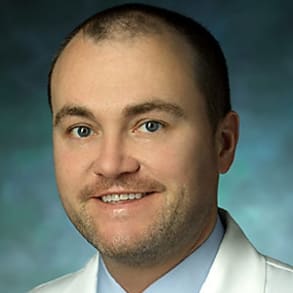Surgical oncologist Dr. Chris Shubert discusses the unique advances Johns Hopkins Hospital has in pancreatic and liver cancer. He answers questions such as: what is ALPPS and what does it treat, how does it combine with hepatic artery infusion pump, and the benefit it has to patients.
Liver surgery is the only potentially curative option for primary tumors of the liver and for some diseases that metastasize to the liver. Unfortunately, many patients aren't candidates for liver surgery or liver surgical removal of these tumors because they have insufficient liver volume, meaning the liver that we would be allowed to leave behind, that's uninvolved by tumor would be too small to support the patient's metabolic demands. However, with an ALPS procedure, we're able to take advantage of the regenerative capacity of the liver or its ability to hypertrophy to allow the liver to grow prior to removing the disease portion of the liver. This makes liver surgery safer and the risk of liver insufficiency and liver failure lower. It also increases the number of patients who are now candidates for potentially curative surgery. So, an alps operation is a type of hepatectomy. A conventional hepatectomy means that a portion of the liver is removed. Uh However, where an alps comes in is if a patient needs a liver resection or a liver surgery, but the liver that would remain in place is too small to support the patient's metabolic demands. An alps procedure allows us to hypertrophy or regenerate the liver remnant to remain in place after surgery. So it is a two staged operation. Whereas in the first stage, we induce hypertrophy of the liver remnant. And in the second stage, we remove the disease portion of the liver. To our knowledge, we are currently the only center offering hepatic artery in fusion pump and alps in a single operation. This is made possible by the experience and expertise of our liver surgical team. The benefit of this procedure is that it allows us to completely remove all tumor from the liver and a single hospitalization that would ordinarily require two or more hospitalization over several months. The way that an ALP is carried out at the first stage, the liver remnant is cleared from all tumor or all disease. The liver is divided where it would normally be divided and the portal vein to the side that will ultimately be removed is also divided. This induces hypertrophy in as short as 7 to 10 days. That would then allow us to go back for the second operation within that 7 to 10 day time frame to remove the disease portion of the liver. Historically, this required two or more operations and that the first stage, the remnant side would be cleared. A portal vein embolization or portal vein ligation would be performed. And then the hypertrophy would typically take six weeks or longer to achieve sufficient growth of the liver remnant at that point. A second operation at a separate hospitalization would be performed. It's important for a patient to come to Johns Hopkins, first and foremost, to get a thorough evaluation. This starts with high quality high definition imaging such as MRI S and C T scans with dedicated liver protocols. We then use those imagings to create three dimensional reconstructions and liver volumetric analysis that's tailored to that patient's liver anatomy as well as their tumor anatomy. This is important because even though we have the capability and expertise and experience to perform alps procedures and even more complicated, more complex liver surgical procedures, many patients who are said to be inoperable or aren't candidates for surgical reception are actually surgical candidates with conventional liver surgical means. However, we do have the experience to perform alps when necessary. We have the expertise to perform more complicated liver surgical procedures when necessary. But I think it's very important to get the initial evaluation done appropriately and accurately to make a plan for the patient that is tailored to them, to ensure best outcome.



